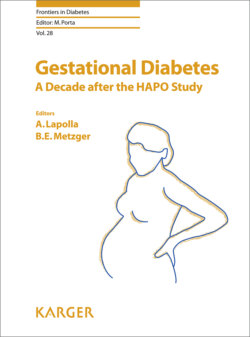Читать книгу Gestational Diabetes - Группа авторов - Страница 21
На сайте Литреса книга снята с продажи.
Steroid and Peptide Hormones (Table 1)
ОглавлениеThe placenta is primarily responsible for bringing about the necessary modifications in maternal metabolism, secreting various hormones and cytokines which mediate the process. The mechanisms for decreasing insulin sensitivity (increasing insulin resistance) appear to be multifactorial. It was initially postulated that progesterone and human placental lactogen (hPL), produced in large quantities by the placenta, were responsible for the above phenomenon [11]. Increasing prolactin and cortisol levels were also invoked, and there is evidence in animal models that these hormones can evoke a postreceptor defect in insulin action [12]. The evidence supporting a role for these hormones included animal models as well as human observational studies showing parallel increases in these hormone levels as pregnancy progresses and insulin resistance develops [13]. Administration of hPL to nonpregnant individuals resulted in insulin resistance [14], and exposure of fat cells in vitro to hPL led to lipolysis [15]. Similarly, when intramuscular progesterone was administered to men, and to women who had previously undergone hysterectomy, plasma insulin responses to oral glucose administration were significantly higher than those in controls not exposed to progesterone, despite similar glucose levels, suggesting insulin resistance similar to that occurring during pregnancy [16]. Maternal prolactin levels increase markedly during pregnancy to about 10 times the normal nonpregnant levels [17]. The impact of maternal prolactin on carbohydrate metabolism during pregnancy is somewhat controversial. Prolactin upregulates β-cells in the pancreatic islets [18], but higher levels in the third trimester were associated with higher maternal glucose levels [19]. Amniotic fluid levels of prolactin are much higher than maternal levels, being produced by the decidua and not crossing to the mother [17]. Maternal pituitary corticotropin-releasing hormone and ACTH rise during pregnancy. Total plasma cortisol as well as plasma and 24-h urine-free cortisol increase as pregnancy progresses, so that the rise in corticosteroid-binding globulin cannot explain all the increase [20]. Cortisol has a well-known negative impact on insulin sensitivity. Estradiol is produced in large amounts by the placenta; its role in carbohydrate metabolism during pregnancy is not well established, but it has been hypothesized to function to protect β-cells against apoptosis and to promote insulin synthesis [21]. Estradiol has been shown to induce diminished peripheral glucose uptake [22].
Table 1. Roles for steroid and peptide hormones in carbohydrate metabolism in pregnancy
A number of other proteins, such as insulin-like growth factors (IGFs), their binding proteins (IGFBPs), and placental growth hormone (PGF) [23] have been postulated to play a role as well. An intriguing possibility concerns the possible interaction between PGF and brown adipose tissue. Brown adipose tissue is primarily involved in maintaining body temperature by nonshivering thermogenesis, the mechanism of which involves the uncoupling of ATP from energy storage so that energy is released as heat. Human studies have demonstrated that, under conditions of cold exposure, brown adipose tissue improves insulin sensitivity and glucose homeostasis in adults [24]. The fetus and newborn have larger stores of brown adipose tissue than do adults, and it is believed to play a highly significant role in neonatal thermoregulation. PGF, produced by placental trophoblasts, was recently shown to activate brown adipocyte function in cultured human fetal adipocytes [36]. PGF levels were shown to be lower in 73 women with gestational diabetes mellitus (GDM) compared to 91 pregnant controls, and the GDMs were found to have lower brown adipocyte activation by infrared thermography in the supraclavicular region which is the usual location of brown adipocytes in adults [25]. PGF is also postulated to contribute to the insulin resistance in late pregnancy, possibly through regulation of IGF-1 [26]. Whether this is yet another mechanism by which placental products regulate insulin sensitivity during pregnancy awaits further study.
Table 2. Roles for adipocytokines in carbohydrate metabolism in pregnancy
